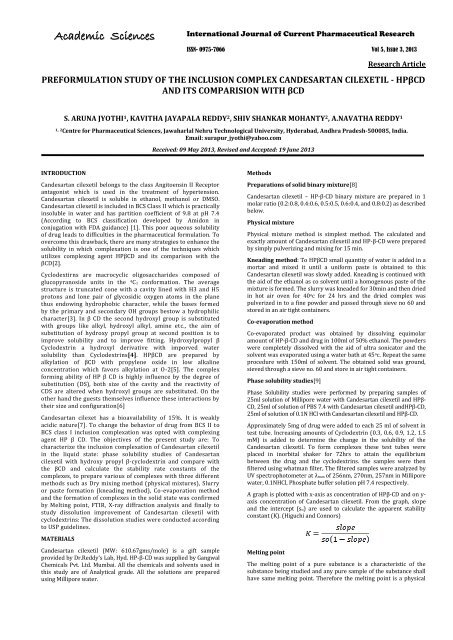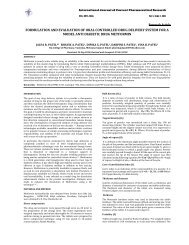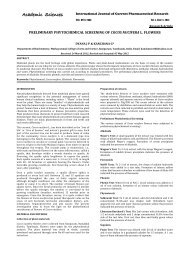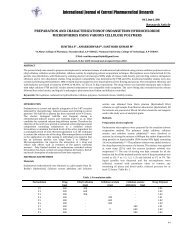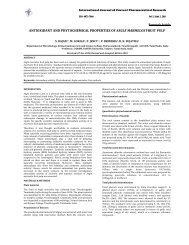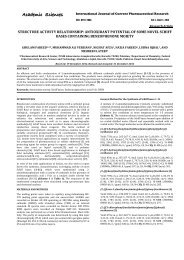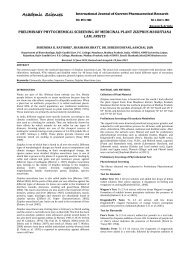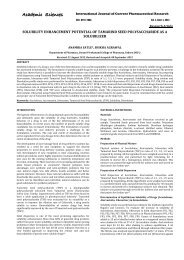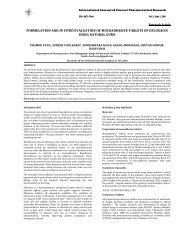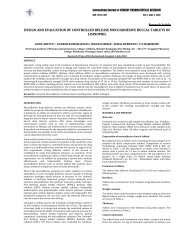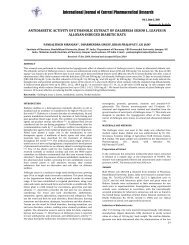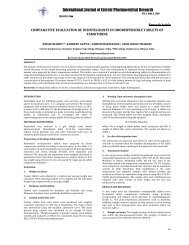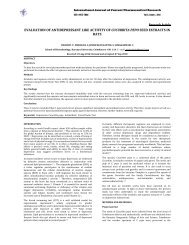preformulation study of the inclusion complex candesartan cilexetil
preformulation study of the inclusion complex candesartan cilexetil
preformulation study of the inclusion complex candesartan cilexetil
Create successful ePaper yourself
Turn your PDF publications into a flip-book with our unique Google optimized e-Paper software.
Jyothi al.Int J Curr Pharm Res, Vol 5, Issue 3, 48-53Fig. 7: Time Vs Percentage drug release <strong>of</strong> <strong>the</strong> 1:1 ratio <strong>of</strong> drug and βCD, HPβCD in 0.1N HClFig. 8: Time Vs Percentage drug release <strong>of</strong> <strong>the</strong> 1:1 ratio <strong>of</strong> drug and βCD, HPβCD in PBS 7.4The percentage drug release from <strong>the</strong> binary mixture withdifferent CDs falls in <strong>the</strong> following said pattern: PBS 7.4 >Millipore Water > 0.1N HClThe percentage drug release from different mixtures, Marketedproduct and API is given as follows: Co evaporated Mixture >Kneaded Mixture > > Physical Mixture≈ Marketed >API By comparing <strong>the</strong> dissolution pr<strong>of</strong>iles <strong>of</strong> 1:1 drug: βCD and 1:1drug: HPβCD in different dissolution media 1:1 drug: βCDshowed <strong>the</strong> maximum dissolution 1:1 drug: βCD > 1:1 drug :HPβCDCONCLUISONThis methodology has provided an important tool in predicting <strong>the</strong>bioavailability studies which in turn depends on <strong>the</strong> solubility <strong>of</strong>drug. Using this concept a BCS Class II drug can be changed to a BCSClass I drug.βCD and HPβCD has shown <strong>the</strong> <strong>complex</strong>ation <strong>of</strong> <strong>the</strong> Candesartan<strong>cilexetil</strong>. The Inclusion <strong>complex</strong>ation <strong>of</strong> <strong>the</strong> drug is influenced by <strong>the</strong>preparation methods <strong>of</strong> binary mixtures and also <strong>the</strong> pH. Thestability constants are varied in different media <strong>of</strong> phase solubilitystudies which indicates that pH influences <strong>the</strong> ionization and alters<strong>the</strong> <strong>complex</strong>ation. Among <strong>the</strong> different ratio <strong>of</strong> 1 molar 0.5:0.5showed <strong>the</strong> maximum drug release. The drug release was maximumin case <strong>of</strong> Co evaporation method followed by Kneading method. Thesolid state characterization was performed using Melting point(where <strong>the</strong> melting point <strong>of</strong> <strong>complex</strong>ation is decreased whencompared to β CD indicating <strong>the</strong> <strong>complex</strong>ation is formed), FTIR,XRD. From <strong>the</strong> results it indicates that compared to parent β-CD <strong>the</strong>HPβCD has lesser ability to form <strong>complex</strong>es with large spheriformstructures.REFERENCES1. Amidon G, Lennarnas H, Shah V, Crison J., “ A <strong>the</strong>oretical basisfor a biopharmaceutics drug classification: <strong>the</strong> correlation <strong>of</strong>invitro drug product dissolution and in vivo bioavailability”.Pharm Res. 1995;12:413–29.2. FDA/CDER, Guidance for industry, waiver <strong>of</strong> in vivobioavailability and bioequivalence studies for immediaterelease solid oral dosage forms based on a biopharmaceuticsclassification system. Washington D.C., August 2000.3. Dr. Helena Dodziuk ,institute <strong>of</strong> physical chemistry“Cyclodextrin and <strong>the</strong>ir <strong>complex</strong>es” published 2006, Pg No1-3.4. Uekama K, Hirayama F and Irie T., “Cyclodextrins drug carriersystem”. Chemical Reviews, 2045-2076, 1998.5. Pitha J & Rao C T, “Distribution <strong>of</strong> substituents in 2-hydroxypropylcyclo e<strong>the</strong>rs <strong>of</strong> cyclomaltoheptaose.”Carbohydrate research,429-435, 19906. Zhengyu Jin, Chao Yuan, Xuehong Li, “Evaluaiton <strong>of</strong> <strong>complex</strong>forming ability <strong>of</strong> hydroxypropl –β-cyclodextrins”, Foodchemistry 106 ,2008, 50-557. Thomas L. Lekme, David A.Williams, Victoria F. Roche,S.William Zito “Foye’s principles <strong>of</strong> medicinal chemistry” 6 <strong>the</strong>dition 2008, 75.8. F.Veiga, J.J.C Teixeria-Dias, F. Kedzierewicz, A.Aousa,P.Maincent, “Inclusion <strong>complex</strong> <strong>of</strong> tolbutamide with β-CD andhydroxy propyl β-CD”, International journal <strong>of</strong> pharmaceutics129, 1996, 63-71.9. T.Higuchi and K.A. Connors ,Phase solubility technique inAdvances in analytical ahemistry and instrumentation,Vol-4,1965; 117-21210. Hsiue, G.-H, Liao, C-M., and Lin, S.-Y “Effect <strong>of</strong> Drug-PolymerInteraction on <strong>the</strong> Release characteristics <strong>of</strong> Methacrylic AcidCopolymer Microcapsules Containing Theophylline”, ArtifOrgans 22 (8), 1998,651-656.52
Jyothi al.Int J Curr Pharm Res, Vol 5, Issue 3, 48-5311. Sarisuta, N Lawanprasert, P., Puttipipatkhachorn, S., andSrikummoon, K., “The Influence <strong>of</strong> Drug-Excipient and Drug-Polymer Interactions on Adhesive Strength <strong>of</strong> RanitidineHydrochloride Film-Coated Tablets”, Drug DevInd Pharm 32(4),2006, 463-471.12. Hirokazu Matsunaga “Solid-State Characterization <strong>of</strong>Candesartan Cilexetil (TCV-116): Crystal Structure andMolecular Mobility”, Chem. Pharm. Bull. 47(2),1999, 182—18613. Gordon l.Amidon, “Drug derivatization as a means <strong>of</strong>solubilisation: Physicochemical and biochemical strategies” Pgno187.14. M. Narender Reddy,Tasneem Rehana,S. Ramakrishna,K. P. R.Chowdary, and Prakash V. Diwan “ β-CyclodextrinComplexes <strong>of</strong> Celecoxib: Molecular-Modeling,Characterization, and Dissolution Studies”,AAPS pharmsci2004;6(1) Article 753


